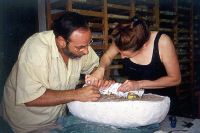Jared Diamond's "Guns, Germs, and Steel"
Using archaeological evidence found during excavations which uncovered granaries for wheat and Barley at Dhra', Jordan, Diamond demonstrates his belief that people were forced into farming and storing because of the bleak environmental conditions caused by the Younger Dryas.
Michael Pollan's "The Botany of Desire"
(The entire documentary can be accessed at: http://video.pbs.org/video/1283872815/)
Pollan takes on a completely different view on domestication seeing it more as a coevolution between humans and non-humans that would eventually lead to codependency between species. In an attempt to answer the age old question of "why domesticated plants exist?", he delves into the biological, chemical, and social changes both actors go through in during the process of domestication.
Haiku Inspired by "The Botany of Desire"
Desire for more
Mutual Understanding
Domestication



